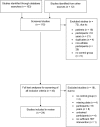High-Intensity Interval Training Performed by Young Athletes: A Systematic Review and Meta-Analysis
- PMID: 30100881
- PMCID: PMC6072873
- DOI: 10.3389/fphys.2018.01012
High-Intensity Interval Training Performed by Young Athletes: A Systematic Review and Meta-Analysis
Abstract
Background: High-intensity interval training (HIIT) is as a time-efficient alternative to moderate- or low-intensity continuous exercise for improving variables related to endurance and anaerobic performance in young and adolescent athletes. Objectives: To assess original research about enhancement of endurance and anaerobic exercise performance in young and adolescent athletes performing HIIT. Method: Relevant articles published in peer-reviewed journals were retrieved from the electronic databases PubMed and SPORTDiscus in December 2017. Inclusion criteria were: (i) controlled trials (HIIT vs. alternative training protocol) with pre-post design; (ii) healthy young athletes (≤18 years); (iii) assessing variables related to endurance and exercise performance. Hedges' g effect size (ES), and associated 95% confidence intervals were calculated for comparison of any outcome between experimental (HIIT) and alternative training protocol. Results: Twenty four studies, involving 577 athletes (mean age: 15.5 ± 2.2 years), were included in this review. HIIT exerted no or small positive mean ES on peak oxygen uptake (VO2peak), running performance, repeated sprint ability, jumping performance and submaximal heart rate. Although the mean ES for changes in VO2peak with HIIT is small (mean g = 0.10±0.28), the average increase in VO2peak from pre to post HIIT-interventions were 7.2 ± 6.9% vs. 4.3 ± 6.9% with any other alternative intervention. HIIT largely and positively affected running speed and oxygen consumption at various lactate- or ventilatory-based thresholds, as well as for sprint running performance. Calculations showed negative mean ES for change-of-direction ability (large), and peak blood lactate concentrations (small). Mean duration per training session for HIIT was shorter than for control interventions (28 ± 15 min vs. 38 ± 24 min). Conclusion: The present findings suggest that young athletes performing HIIT may improve certain important variables related to aerobic, as well as anaerobic, performance. With HIIT, most variables related to endurance improved to a higher extent, compared to alternative training protocols. However, based on ES, HIIT did not show clear superiority to the alternative training protocols. Nevertheless, young athletes may benefit from HIIT as it requires less time per training session leaving more time for training sport specific skills.
Keywords: adolescents; aerobic training; peak oxygen uptake; physical fitness; training intensity.
Figures
Similar articles
-
Effects of High-Intensity Interval Training in School on the Physical Performance and Health of Children and Adolescents: A Systematic Review with Meta-Analysis.Sports Med Open. 2022 Apr 11;8(1):50. doi: 10.1186/s40798-022-00437-8. Sports Med Open. 2022. PMID: 35403996 Free PMC article.
-
A Meta-Comparison of the Effects of High-Intensity Interval Training to Those of Small-Sided Games and Other Training Protocols on Parameters Related to the Physiology and Performance of Youth Soccer Players.Sports Med Open. 2019 Feb 21;5(1):7. doi: 10.1186/s40798-019-0180-5. Sports Med Open. 2019. PMID: 30790134 Free PMC article. Review.
-
Effects of high-intensity interval training on selected indicators of physical fitness among male team-sport athletes: A systematic review and meta-analysis.PLoS One. 2024 Nov 13;19(11):e0310955. doi: 10.1371/journal.pone.0310955. eCollection 2024. PLoS One. 2024. PMID: 39536016 Free PMC article.
-
Effects of High-Intensity Interval Training in Combat Sports: A Systematic Review with Meta-Analysis.J Strength Cond Res. 2020 Mar;34(3):888-900. doi: 10.1519/JSC.0000000000003255. J Strength Cond Res. 2020. PMID: 31904713
-
Meta-analyses of the effects of high-intensity interval training in elite athletes - part II: relationships between the mean effects on various performance measures.Front Physiol. 2024 Dec 23;15:1486570. doi: 10.3389/fphys.2024.1486570. eCollection 2024. Front Physiol. 2024. PMID: 39764379 Free PMC article.
Cited by
-
Minimal Detectable Change in Resting Blood Pressure and Cardiorespiratory Fitness: A Secondary Analysis of a Study on School-Based High-Intensity Interval Training Intervention.J Clin Med. 2023 Sep 23;12(19):6146. doi: 10.3390/jcm12196146. J Clin Med. 2023. PMID: 37834790 Free PMC article.
-
Combined treatment of high-intensity interval training with neural stem cell generation on contusive model of spinal cord injury in rats.Brain Behav. 2023 Jul;13(7):e3043. doi: 10.1002/brb3.3043. Epub 2023 May 11. Brain Behav. 2023. PMID: 37165750 Free PMC article.
-
Is Maturational Growth More Influential than Training Engagement in Longitudinal Adolescent Physical Performance Development?Eur J Sport Sci. 2025 May;25(5):e12293. doi: 10.1002/ejsc.12293. Eur J Sport Sci. 2025. PMID: 40222020 Free PMC article.
-
PREDICTORS OF JUDO-SPECIFIC TASKS FROM NEUROMUSCULAR PERFORMANCE IN YOUNG ATHLETES AGED 11-16 YEARS.Int J Sports Phys Ther. 2020 May;15(3):365-373. Int J Sports Phys Ther. 2020. PMID: 32566372 Free PMC article.
-
Effects of High-Intensity Interval Training in School on the Physical Performance and Health of Children and Adolescents: A Systematic Review with Meta-Analysis.Sports Med Open. 2022 Apr 11;8(1):50. doi: 10.1186/s40798-022-00437-8. Sports Med Open. 2022. PMID: 35403996 Free PMC article.
References
-
- Armstrong N., McManus A. M. (2011). The Elite Young Athlete. Basel: Karger.
-
- Bailey R. C., Olson J., Pepper S. L., Porszasz J., Barstow T. J., Cooper D. M. (1995). The level and tempo of children's physical activities: an observational study. Med. Sci. Sports Exerc. 27, 1033–1041. - PubMed
LinkOut - more resources
Full Text Sources
Other Literature Sources



